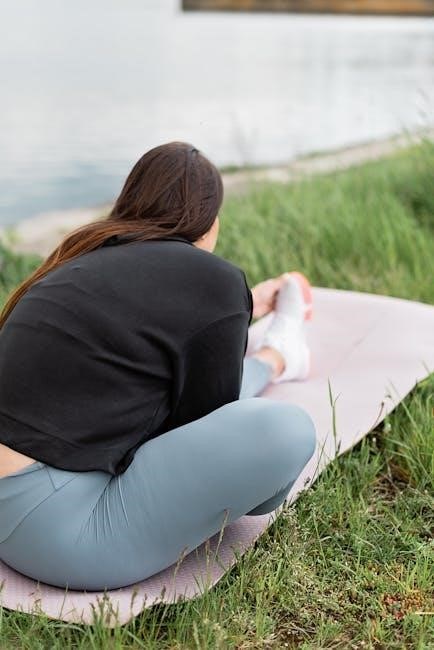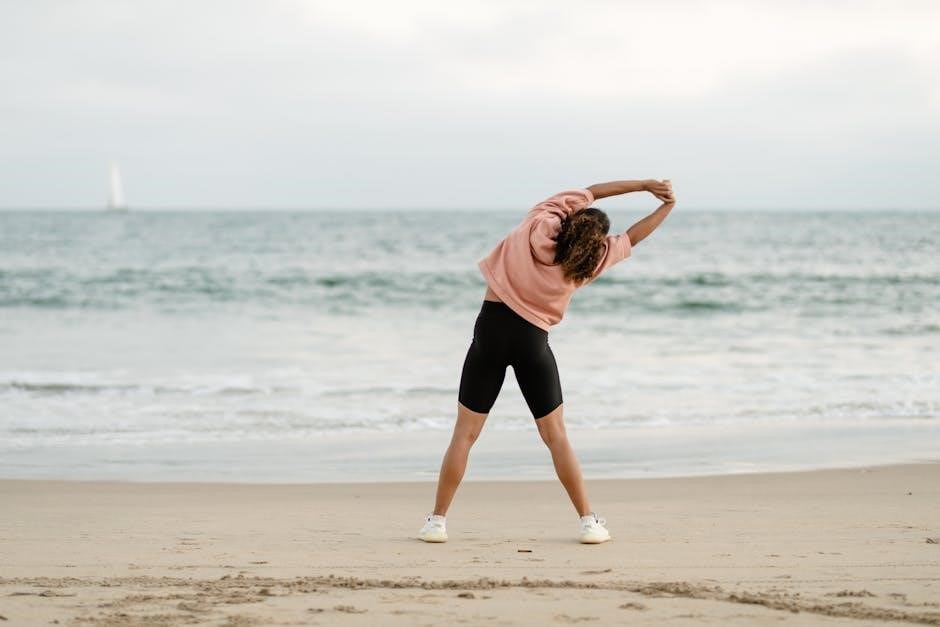
morning stretch routine pdf
Welcome to our comprehensive guide on morning stretch routines! Discover how starting your day with stretching can boost energy, enhance flexibility, and set a positive tone.
1.1 Importance of Morning Stretching
Morning stretching is essential for activating muscles, improving joint mobility, and preparing the body for daily activities. It enhances blood flow and oxygen delivery to tissues, boosting energy levels and mental clarity. Regular morning stretching helps maintain proper posture, reduces muscle tension, and lowers the risk of injuries. Consistency in this practice fosters a healthy lifestyle, promoting overall well-being and resilience. By incorporating stretching into your morning routine, you set a positive tone for the day, encouraging physical and mental readiness. Over time, it becomes a foundational habit that supports long-term health and vitality.
1.2 Benefits of Starting the Day with Stretching
Starting your day with stretching offers numerous benefits, including improved flexibility, enhanced circulation, and increased energy. It helps reduce morning stiffness, making movement feel more natural. Stretching also boosts mental alertness and focus, preparing you for the day ahead. Regular practice can improve posture, reduce muscle soreness, and even enhance athletic performance. Additionally, it provides a moment of mindfulness, helping to reduce stress and set a positive tone. Incorporating stretching into your morning routine can lead to better overall physical and mental well-being, making it an excellent habit to adopt for long-term health benefits.
1.3 How to Create a Consistent Morning Stretch Routine
To create a consistent morning stretch routine, start by setting realistic goals and scheduling a specific time each day. Begin with short sessions and gradually increase duration as the habit forms. Incorporate a mix of dynamic and static stretches to keep the routine engaging. Focus on major muscle groups like hamstrings, hips, and shoulders. Use a stretching guide or app for structure and variety. Track your progress to stay motivated and ensure consistency. Make it a habit by pairing stretching with other morning rituals, like brushing your teeth or drinking water. Over time, it will become an integral part of your daily routine.

Understanding the Anatomy of Stretching
Understanding the anatomy of stretching involves focusing on major muscle groups and key joints, enhancing flexibility and promoting proper movement in your morning routine.
2.1 Major Muscle Groups to Focus On
Focusing on major muscle groups like hamstrings, quadriceps, hip flexors, chest, and shoulders is essential for a balanced morning stretch routine. These areas are crucial for daily movement and posture. Stretching hamstrings and hip flexors improves flexibility, while targeting the chest and shoulders helps counteract slouching. Incorporating exercises that engage these muscle groups ensures comprehensive flexibility and reduces injury risk. Prioritizing these areas in your morning routine will enhance overall mobility and set a strong foundation for the day ahead, promoting both comfort and energy.
2.2 Key Joints and Their Roles in Stretching
Key joints such as the hips, knees, shoulders, and spine play vital roles in stretching. The hips are essential for mobility, while tight hip flexors can lead to poor posture. Knees require careful attention to avoid injury during deep stretches. Shoulders are critical for maintaining proper alignment and range of motion. The spine, as the central axis, benefits from gentle twists and extensions to enhance flexibility. Focusing on these joints ensures a balanced and effective stretching routine, improving overall mobility and reducing stiffness. Prioritizing joint health in your morning stretches will help you move more freely and maintain long-term physical well-being.

2.3 The Science Behind Muscle Flexibility
Muscle flexibility is influenced by the elasticity of muscle fibers, tendons, and ligaments. When stretching, these tissues lengthen, reducing muscle tension and improving joint mobility. Regular stretching enhances blood flow, delivering oxygen and nutrients to muscles, which promotes healing and relaxation. Over time, consistent stretching can remodel connective tissue, increasing its extensibility. The nervous system also plays a role, as repeated stretching signals muscles to relax, improving flexibility. Understanding this science helps tailor stretches to specific muscle groups, maximizing effectiveness and reducing injury risk. By incorporating stretching into your routine, you harness these physiological responses to achieve greater flexibility and overall well-being.
Preparing for Your Morning Stretch Routine
Start by setting a consistent wake-up time, gather essential props like mats or straps, and warm up with light movements to prepare your body for stretching.
3.1 The Best Time to Stretch in the Morning
The optimal time to stretch in the morning is immediately after waking up or within 30 minutes. Stretching upon waking helps increase blood flow and energy levels, preparing your body for the day. However, allowing a short period after waking can help your muscles warm up naturally, enhancing flexibility. Consistency is key, so choose a time that fits your schedule and stick to it. Morning stretching not only improves mobility but also sets a positive tone, making it easier to maintain a daily routine. Aim for 10–15 minutes to reap the full benefits.
3.2 Essential Equipment for Stretching
While stretching can be done with minimal equipment, having the right tools enhances comfort and effectiveness. A high-quality yoga mat provides grip and cushioning, protecting joints during floor exercises. Resistance bands or straps are ideal for deepening stretches, especially for hamstrings and hips. Foam rollers can be used for self-myofascial release, loosening tight muscles. Blocks or pillows are helpful for modifying stretches, making them accessible for all fitness levels. Additionally, wearing comfortable, flexible clothing allows for a full range of motion. These tools can elevate your morning stretch routine, ensuring safety and maximizing benefits. Invest in durable equipment to support long-term consistency and progress.
3.3 Warming Up Before Stretching
A proper warm-up is crucial before stretching to prepare muscles and joints, enhancing flexibility and reducing injury risk. Light cardio like jogging in place or jumping jacks increases blood flow and temperature; Dynamic movements, such as arm circles and leg swings, gently activate major muscle groups. Incorporating gentle twists and torso rotations further awakens the body. A warm-up of 5-10 minutes ensures muscles are receptive to stretching, improving its effectiveness. Always prioritize this step to maximize the benefits of your morning stretch routine and maintain overall muscle health. Consistency in warming up leads to better flexibility and a safer exercise experience.
Types of Morning Stretches
Explore various morning stretches, including dynamic stretches for energy, static stretches for flexibility, yoga-inspired poses for relaxation, and Pilates-based exercises for core strength and alignment.
4.1 Dynamic Stretches for Morning Energy
Dynamic stretches are a vibrant way to kickstart your morning, boosting energy and preparing your body for the day. These active movements, like arm circles, leg swings, and torso twists, increase blood flow and warm up your muscles. Unlike static stretches, dynamic stretches involve continuous motion, enhancing flexibility and range of motion without strain. They’re perfect for waking up your body and invigorating your mind, setting a refreshing tone for the day ahead. Incorporate dynamic stretches into your routine to feel more alert, focused, and ready to tackle morning tasks with vitality and enthusiasm.
4.2 Static Stretches for Flexibility
Static stretches are a cornerstone of any effective morning routine, focusing on holding positions to enhance flexibility and relieve muscle tension. These stretches involve extending specific muscle groups, such as hamstrings, quadriceps, and hip flexors, and maintaining the pose for 20-30 seconds. By targeting major joints like the shoulders, hips, and knees, static stretches improve range of motion and reduce stiffness. Incorporating moves like the seated forward bend, chest opener, and standing side stretch can help realign muscle fibers and prepare your body for daily activities. Consistency in static stretching not only boosts flexibility but also promotes better posture and overall physical comfort.
4.3 Yoga-Inspired Morning Stretches
Yoga-inspired stretches offer a holistic approach to morning routines, blending physical movement with mindfulness. Poses like the downward-facing dog, cobra, and cat-cow gently awaken the body, improving circulation and flexibility. Warrior poses strengthen and stretch the legs and hips, while the child’s pose provides relaxation. Sun salutations combine dynamic movements to energize and warm up muscles, preparing them for the day ahead. These stretches not only enhance flexibility but also reduce stress and promote mental clarity, making them an ideal way to start your morning with balance and vitality.
4.4 Pilates-Based Morning Stretch Routine
A Pilates-based morning stretch routine focuses on core engagement, body alignment, and controlled movements. Exercises like the hundred, roll-up, and single-leg stretch improve flexibility and strengthen the abdominals. The spine stretch and cat-cow variations enhance posture and relieve tension. Pilates emphasizes mindful breathing, promoting relaxation and focus. Incorporating these stretches into your morning routine can improve balance, coordination, and overall physical awareness. By combining strength and flexibility, Pilates-inspired stretches prepare your body for the day ahead while fostering a connection between mind and body. This routine is ideal for those seeking a low-impact yet effective way to awaken and energize their muscles.
Targeting Specific Muscle Groups

Focus on key areas like neck, shoulders, hamstrings, and lower back to improve flexibility and reduce muscle tension. This approach helps prevent injuries and enhances posture naturally.

5.1 Neck and Shoulder Stretches
Neck and shoulder stretches are essential for relieving tension and improving posture. Start with gentle tilts and rotations of the neck, holding each position for 20-30 seconds. For shoulders, try shoulder rolls and arm circles to loosen tight muscles. The cat-cow stretch is also effective for the neck and upper back. Physical therapists recommend incorporating these stretches to reduce the risk of strain and enhance mobility. Perform these exercises slowly and avoid bouncing to prevent injury. Regular practice can help alleviate stiffness and promote relaxation, making it easier to tackle daily activities with renewed energy and comfort.
5.2 Chest and Upper Back Stretches
Chest and upper back stretches are crucial for improving posture and reducing muscle tightness. Begin with a standing chest stretch, placing your hands on a wall or door frame and leaning forward gently. The cross-body shoulder stretch is another effective option, pulling one arm across your chest to target the upper back. For a deeper stretch, try the cat-cow pose or use a resistance band to enhance flexibility. These exercises help counteract the effects of sitting for long periods and promote better spinal alignment. Hold each stretch for 20-30 seconds and repeat 2-3 times for maximum benefit. Breathe deeply to relax further.
5.3 Hamstring and Hip Flexor Stretches
Hamstring and hip flexor stretches are essential for improving flexibility and reducing stiffness in the legs and lower body. Begin with a standing hamstring stretch, bending forward at the hips and reaching toward your toes. For the hip flexors, perform a kneeling lunge stretch, pushing your hips forward to feel the stretch in the front of your leg. The seated forward bend also targets the hamstrings, while the supine hamstring stretch with a strap can deepen the stretch. These exercises help prevent tightness from sitting and enhance mobility for daily activities. Hold each stretch for 20-30 seconds and repeat 2-3 times for optimal results. Deep breathing can enhance relaxation and effectiveness.
5.4 Lower Back and Core Stretches
Lower back and core stretches are vital for maintaining spinal health and improving posture. Begin with the cat-cow stretch, gently arching and rounding your back while on all fours. The child’s pose is another effective stretch, extending the spine and hips. For the core, incorporate a seated spinal twist, rotating your torso and holding for 30 seconds per side. The bird-dog stretch strengthens the lower back and core by extending opposite arms and legs. These exercises enhance flexibility, reduce stiffness, and promote better movement patterns. Perform each stretch slowly, focusing on deep breathing to maximize relaxation and effectiveness. Aim for 2-3 repetitions of each stretch to support spinal alignment and core stability.

Duration and Frequency of Stretching
A morning stretch routine should last 10-15 minutes, focusing on key muscle groups. Aim to stretch 3-4 times weekly for optimal flexibility and muscle relaxation benefits.
6.1 How Long Should a Morning Stretch Routine Last?
A morning stretch routine should typically last between 10 to 15 minutes. This duration allows for a comprehensive session targeting major muscle groups without causing fatigue. Starting with dynamic stretches to awaken the body, followed by static stretches for flexibility, ensures a balanced approach. It’s important to allocate enough time to cover all essential areas, such as hamstrings, hips, shoulders, and lower back, while maintaining focus and proper form. A shorter routine may miss key stretches, while a longer one might lead to overexertion. Consistency is key, so aim for a routine that fits seamlessly into your morning schedule, promoting energy and readiness for the day ahead.
6.2 How Often Should You Stretch in the Morning
Stretching in the morning should ideally be done 4 to 7 times a week, with daily practice being the most beneficial for improving flexibility and posture. Consistency is key, as irregular stretching may not yield significant progress. Even a short, 5-10 minute routine each morning can make a noticeable difference over time. It’s important to listen to your body and adjust frequency based on how you feel. If you’re just starting, aim for 3-4 times a week and gradually increase as your body adapts. Remember, the goal is to create a sustainable habit that enhances your overall well-being and energy levels throughout the day.
6.3 Balancing Stretching with Other Morning Activities
Balancing stretching with other morning activities requires planning and prioritization. Begin by assessing your morning routine and allocating specific time slots. If you have a 30-minute window, dedicate 10 minutes to stretching, 10 to hygiene, and the remaining to breakfast or other tasks. For busier days, even a 5-minute stretch can be beneficial. Pair stretching with activities like brushing teeth or waiting for coffee to maximize efficiency. Consistency is crucial, so adjust the routine according to your schedule without compromising on stretching. This balance ensures you start your day energized and focused while maintaining productivity and overall well-being. Adapt as needed to keep it sustainable and enjoyable.

Safety and Precautions
Ensure a safe morning stretch routine by avoiding overextension and using proper techniques. Listen to your body to prevent injuries and promote a healthy practice consistently.
7.1 Common Mistakes to Avoid While Stretching
Avoid common mistakes like bouncing during stretches, which can cause muscle tears. Never force a stretch beyond a comfortable range, as this may lead to injury. Holding your breath is another pitfall; instead, breathe deeply to relax muscles. Stretching on a cold muscle increases risk of strain, so always warm up first. Ignoring pain is a mistake—stop if discomfort arises. Overstretching can reduce muscle stability, so focus on gentle, controlled movements. By being mindful of these errors, you can ensure a safe and effective morning stretch routine that enhances flexibility without harm. Proper form and awareness are key to maximizing benefits while minimizing risks. Keep your stretches smooth and deliberate to maintain muscle integrity and overall well-being. This approach fosters a consistent and injury-free practice, allowing you to enjoy the full advantages of morning stretching for improved mobility and energy throughout the day. Consistency and caution will help you achieve long-term flexibility goals safely and effectively.
7.2 Stretching for People with Injuries

For individuals with injuries, stretching must be approached with caution to avoid further harm. Always consult a healthcare professional or physical therapist before starting a stretch routine, especially if recovering from an injury. Modify stretches to accommodate limitations, focusing on low-intensity movements that promote healing without strain. Avoid bouncing or forcing stretches, as this can exacerbate injuries. Use props like straps or pillows to adapt stretches safely. Pain is a red flag—stop immediately if discomfort arises. Prioritize gentle, controlled movements and allow time for recovery between sessions. This tailored approach ensures stretching supports rehabilitation rather than hindering it, fostering a safe return to full mobility. Consistency and patience are key to avoiding setbacks and achieving gradual improvement in flexibility and strength. By adapting stretches to individual needs, injuries can heal while maintaining or improving range of motion and overall well-being.
7.3 Modifying Stretches for Different Fitness Levels
Modifying stretches for different fitness levels ensures everyone can benefit safely and effectively. For beginners, start with gentle, shorter holds and focus on proper form. Use props like straps or pillows to assist with flexibility. Intermediate individuals can gradually increase hold durations or incorporate dynamic stretches. Advanced practitioners might explore deeper stretches or combine movements for enhanced mobility. Always listen to your body and adjust based on comfort and ability. Consulting a professional can help tailor stretches to individual needs. By adapting routines, anyone can enjoy the benefits of stretching, regardless of fitness level, promoting progress and preventing plateaus. Consistency and gradual adjustments are key to long-term success. This approach fosters inclusivity and ensures a safe, enjoyable experience for all participants.

Tracking Progress and Staying Motivated
Tracking progress in your morning stretch routine helps maintain motivation. Set realistic goals, use a journal to monitor improvements, and celebrate small milestones to stay inspired and consistent.
8.1 How to Track Improvement in Flexibility
Tracking improvement in flexibility requires consistent monitoring and measurable methods. Use a journal to record daily stretch progress, noting range of motion and ease of movement. Incorporate photos or videos to visually document changes over time. Regularly measure tightness in key muscle groups using a flexibility ruler or app. Set specific, achievable milestones to celebrate progress, such as touching your toes or completing a difficult pose. Additionally, incorporate periodic assessments like the sit-and-reach test to quantify improvements. Tracking not only highlights gains but also keeps you motivated to continue your morning stretch routine consistently.
8.2 Setting Realistic Goals for Your Stretch Routine
Setting realistic goals is essential to maintaining motivation and consistency in your morning stretch routine. Start by identifying specific, achievable objectives, such as increasing flexibility in a particular muscle group or mastering a challenging pose. Break down larger goals into smaller, manageable steps to avoid frustration. For example, aim to hold a stretch for 10 seconds longer each week or gradually deepen your forward fold over time. Regularly evaluate your progress and adjust your goals as needed. Celebrate milestones, no matter how small, to stay inspired. Align your goals with your personal fitness journey to ensure they remain relevant and motivating.
8.3 Staying Consistent with Your Morning Stretch Routine
Consistency is key to making morning stretching a lasting habit. Schedule your stretch routine at the same time daily, such as immediately after waking up or post-shower. Create a conducive environment by keeping your yoga mat or stretching tools visible. Track your progress in a journal or app to stay motivated. Reward yourself for milestones, like completing a week of stretches. Surround yourself with positive reinforcement, such as inspiring quotes or a supportive community. Most importantly, embrace flexibility—miss a day occasionally without guilt. Over time, consistency will become second nature, transforming your morning stretch routine into a cherished daily ritual.
The Role of Stretching in Overall Health
Stretching enhances blood flow, boosting energy and mental clarity. It supports posture, reduces muscle tension, and improves overall physical well-being, helping maintain a balanced and healthy lifestyle daily.
9.1 Improving Posture Through Morning Stretching
Morning stretching plays a crucial role in enhancing posture by strengthening core muscles and increasing flexibility. Regular stretches like cat-cow, figure-4, and hamstring stretches help align the spine and relieve tension. By targeting the neck, shoulders, and lower back, morning routines can reduce slouching and promote a straighter, more confident stance. Improved posture not only prevents long-term back pain but also enhances breathing and overall physical comfort. Incorporating these stretches into your daily routine ensures better spinal alignment and reduces the risk of posture-related injuries, helping you maintain a healthier and more balanced lifestyle throughout the day.

9.2 Enhancing Circulation and Energy Levels
Morning stretching significantly enhances blood circulation, ensuring oxygen and nutrients reach all body cells efficiently. This boost in circulation leads to increased energy levels, helping you feel more alert and ready for the day. Stretching movements like arm circles, leg swings, and torso twists stimulate blood flow, invigorating the body. Improved circulation also supports muscle recovery and reduces stiffness, making it easier to tackle daily activities with vigor. By incorporating dynamic stretches, you can awaken your body, kickstart your metabolism, and maintain a lively, energetic state throughout the morning. This natural energy surge is a perfect way to begin your day feeling refreshed and revitalized.
9.3 Reducing Stress and Anxiety with Stretching
Morning stretching is a powerful tool for reducing stress and anxiety by promoting relaxation and calming the mind. Gentle movements help release physical tension, easing tight muscles often associated with stress. Stretching stimulates the release of endorphins, the body’s natural mood enhancers, which help alleviate anxiety and improve overall emotional well-being. Additionally, focusing on breathing during stretches creates a mindfulness practice, diverting attention from stressful thoughts and fostering a sense of calm. Regular morning stretching can lower cortisol levels, helping you start the day with a clearer mind and a more resilient attitude to handle life’s challenges with greater ease and confidence.
Morning stretching routines offer numerous benefits, from boosting energy to enhancing flexibility and mental clarity. Embrace this habit to start your day with renewed vitality and positivity.
10.1 Summarizing the Benefits of a Morning Stretch Routine
A morning stretch routine offers numerous benefits, including improved flexibility, enhanced circulation, and increased energy levels. It helps reduce muscle tension, boosting posture and mental clarity. Regular stretching can also lower stress and anxiety, setting a positive tone for the day. By incorporating stretches targeting major muscle groups, individuals can experience better range of motion and overall physical comfort. Consistency is key to achieving these benefits, making it a valuable habit for long-term health and wellness. Start your day with purpose and vitality by embracing a morning stretch routine tailored to your needs and goals.
10.2 Encouraging Others to Adopt the Routine
Sharing the benefits of a morning stretch routine can inspire others to adopt healthy habits. Lead by example and demonstrate how stretching improves energy and reduces stress. Encourage friends and family by highlighting the positive impact it has had on your life. Provide resources, such as simple stretches or videos, to help them get started. Emphasize the importance of consistency and how it can become a enjoyable part of their daily routine. By fostering a supportive environment, you can help others experience the transformative power of morning stretching and improve their overall well-being.
10.3 Final Thoughts on Making Stretching a Lifestyle Habit
Incorporating a morning stretch routine into your daily life is a simple yet powerful way to enhance overall health and well-being. Consistency is key, as regular stretching improves flexibility, reduces muscle tension, and boosts energy levels. By making it a habit, you’ll find it easier to maintain a positive mindset and tackle daily challenges with confidence. Remember, every small step counts, and even a few minutes each morning can lead to significant long-term benefits. Embrace stretching as a lifelong practice and enjoy the transformative effects it brings to your body and mind. Start today and make it a lasting commitment to yourself.